Page 113 of 436

Ensure that the shift lever is fully in PARK (P)
before starting the engine. Your vehicle has
an automatic transaxle shift lock control system.
You have to apply your regular brakes before you
can shift from PARK (P) when the key is in ON.
If you cannot shift out of PARK (P) while holding
the brake pedal down, seeShifting Out of Park (P)
on page 120.
REVERSE (R):Use this gear to back up.
When shifting from NEUTRAL (N) to
REVERSE (R), you need to apply the regular
brake and push the release button on the front of
the shifter and then forward.
Notice:Shifting to REVERSE (R) while your
vehicle is moving forward could damage
the transaxle. The repairs would not be
covered by your warranty. Shift to
REVERSE (R) only after your vehicle is
stopped.
To rock your vehicle back and forth to get out of
snow, ice or sand without damaging your
transaxle, seeIf Your Vehicle is Stuck in Sand,
Mud, Ice, or Snow on page 248.NEUTRAL (N):In this position, your engine does
not connect with the wheels. To restart while
you are already moving, use NEUTRAL (N) only.
Also, use NEUTRAL (N) when your vehicle is
being towed.
{CAUTION:
Shifting into a drive gear while your
engine is running at high speed is
dangerous. Unless your foot is �rmly on
the brake pedal, your vehicle could move
very rapidly. You could lose control and
hit people or objects. Do not shift into a
drive gear while your engine is running at
high speed.
Notice:Shifting out of PARK (P) or
NEUTRAL (N) while the engine is running at
high speed may damage the transaxle.
The repairs would not be covered by your
warranty. Be sure the engine is not running at
high speeds when shifting your vehicle.
113
Page 124 of 436
Mirrors
Manual Rearview Mirror
While sitting in a comfortable driving position,
adjust the mirror so you can see clearly behind
your vehicle. Grip the mirror in the center to move
it up or down and side to side. The control at
the bottom of the mirror is the day/night feature
that allows adjustment to the mirror so that
the glare of headlamps from behind is reduced.
Push the control for daytime use; pull it for
night use.
Outside Manual Mirrors
The outside rearview mirrors should be adjusted
so you can see a little of the side of your
vehicle when you are sitting in a comfortable
driving position.
Adjust the outside manual mirrors using the
control lever located next to the mirror.
The outside rearview mirrors can be folded flat
against the side of the vehicle by pushing
them toward the vehicle’s doors.
124
Page 125 of 436
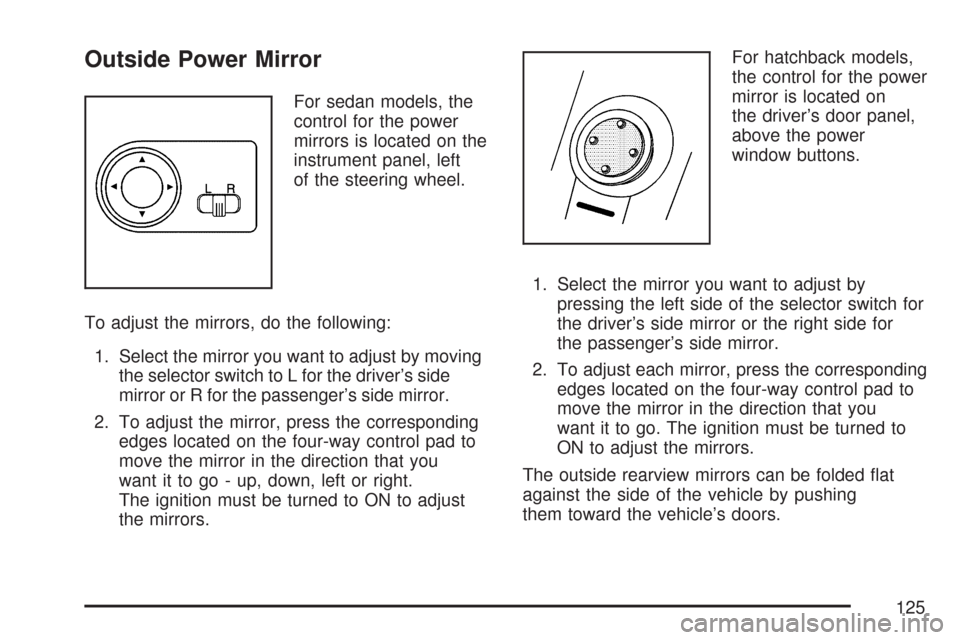
Outside Power Mirror
For sedan models, the
control for the power
mirrors is located on the
instrument panel, left
of the steering wheel.
To adjust the mirrors, do the following:
1. Select the mirror you want to adjust by moving
the selector switch to L for the driver’s side
mirror or R for the passenger’s side mirror.
2. To adjust the mirror, press the corresponding
edges located on the four-way control pad to
move the mirror in the direction that you
want it to go - up, down, left or right.
The ignition must be turned to ON to adjust
the mirrors.For hatchback models,
the control for the power
mirror is located on
the driver’s door panel,
above the power
window buttons.
1. Select the mirror you want to adjust by
pressing the left side of the selector switch for
the driver’s side mirror or the right side for
the passenger’s side mirror.
2. To adjust each mirror, press the corresponding
edges located on the four-way control pad to
move the mirror in the direction that you
want it to go. The ignition must be turned to
ON to adjust the mirrors.
The outside rearview mirrors can be folded flat
against the side of the vehicle by pushing
them toward the vehicle’s doors.
125
Page 138 of 436
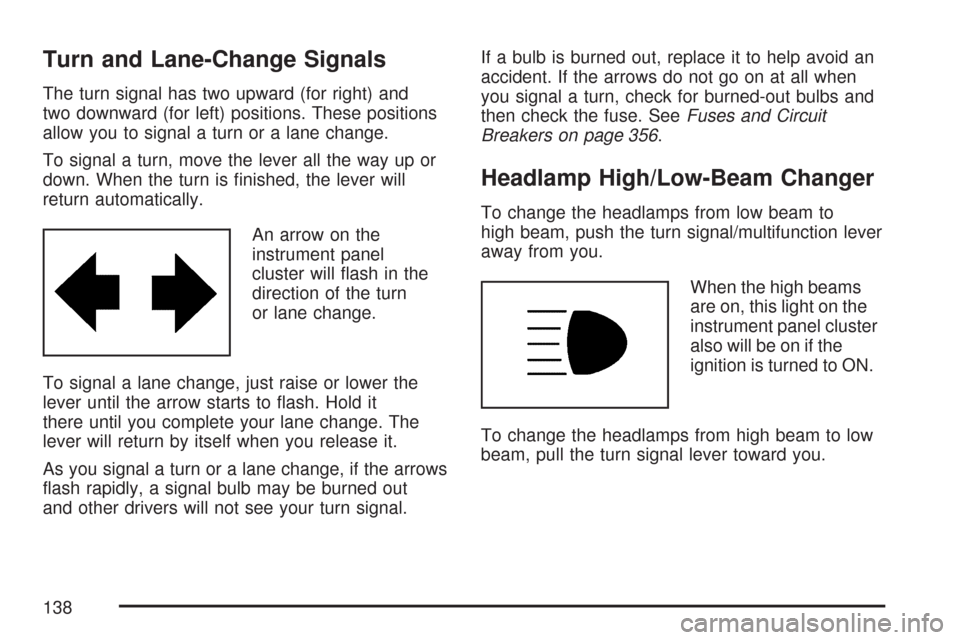
Turn and Lane-Change Signals
The turn signal has two upward (for right) and
two downward (for left) positions. These positions
allow you to signal a turn or a lane change.
To signal a turn, move the lever all the way up or
down. When the turn is finished, the lever will
return automatically.
An arrow on the
instrument panel
cluster will flash in the
direction of the turn
or lane change.
To signal a lane change, just raise or lower the
lever until the arrow starts to flash. Hold it
there until you complete your lane change. The
lever will return by itself when you release it.
As you signal a turn or a lane change, if the arrows
flash rapidly, a signal bulb may be burned out
and other drivers will not see your turn signal.If a bulb is burned out, replace it to help avoid an
accident. If the arrows do not go on at all when
you signal a turn, check for burned-out bulbs and
then check the fuse. SeeFuses and Circuit
Breakers on page 356.
Headlamp High/Low-Beam Changer
To change the headlamps from low beam to
high beam, push the turn signal/multifunction lever
away from you.
When the high beams
are on, this light on the
instrument panel cluster
also will be on if the
ignition is turned to ON.
To change the headlamps from high beam to low
beam, pull the turn signal lever toward you.
138
Page 139 of 436
Flash-to-Pass
This feature lets you use your high-beam
headlamps to signal a driver in front of you that
you want to pass.
To use it, pull the turn signal/multifunction lever
toward you until the high-beam headlamps
come on, then release the lever to turn them off.
Windshield Wipers
Use this lever located on the right side of the
steering wheel to operate the windshield wipers.
The ignition must be turned to ON to operate
the windshield wipers.
HI (High Speed):Move the lever to this position
for wiping at high speed.
LO (Low Speed):Move the lever to this position
for steady wiping at low speed.
Sedan shown, Hatchback similar
139
Page 140 of 436
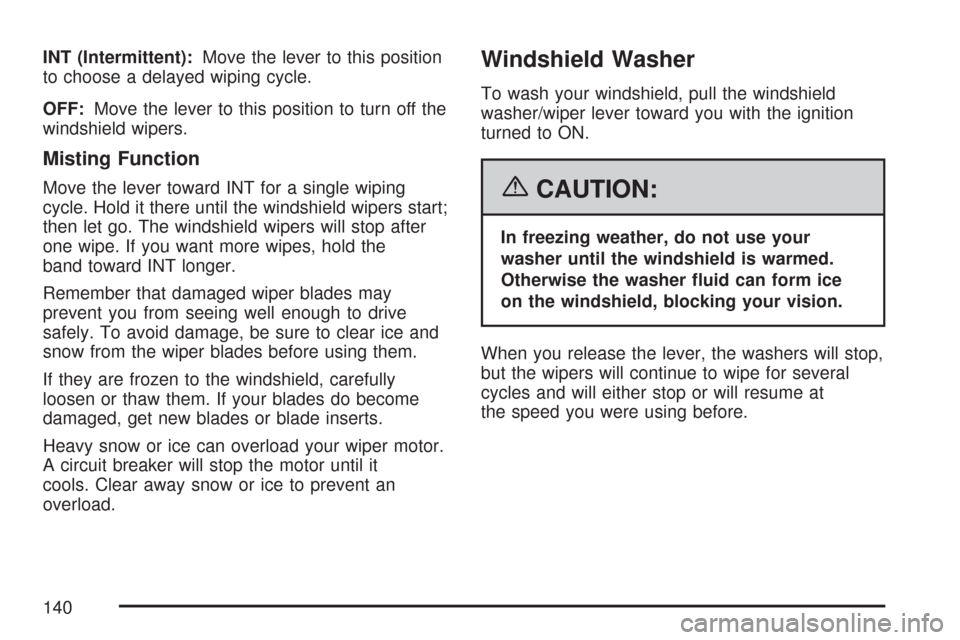
INT (Intermittent):Move the lever to this position
to choose a delayed wiping cycle.
OFF:Move the lever to this position to turn off the
windshield wipers.
Misting Function
Move the lever toward INT for a single wiping
cycle. Hold it there until the windshield wipers start;
then let go. The windshield wipers will stop after
one wipe. If you want more wipes, hold the
band toward INT longer.
Remember that damaged wiper blades may
prevent you from seeing well enough to drive
safely. To avoid damage, be sure to clear ice and
snow from the wiper blades before using them.
If they are frozen to the windshield, carefully
loosen or thaw them. If your blades do become
damaged, get new blades or blade inserts.
Heavy snow or ice can overload your wiper motor.
A circuit breaker will stop the motor until it
cools. Clear away snow or ice to prevent an
overload.
Windshield Washer
To wash your windshield, pull the windshield
washer/wiper lever toward you with the ignition
turned to ON.
{CAUTION:
In freezing weather, do not use your
washer until the windshield is warmed.
Otherwise the washer �uid can form ice
on the windshield, blocking your vision.
When you release the lever, the washers will stop,
but the wipers will continue to wipe for several
cycles and will either stop or will resume at
the speed you were using before.
140
Page 164 of 436
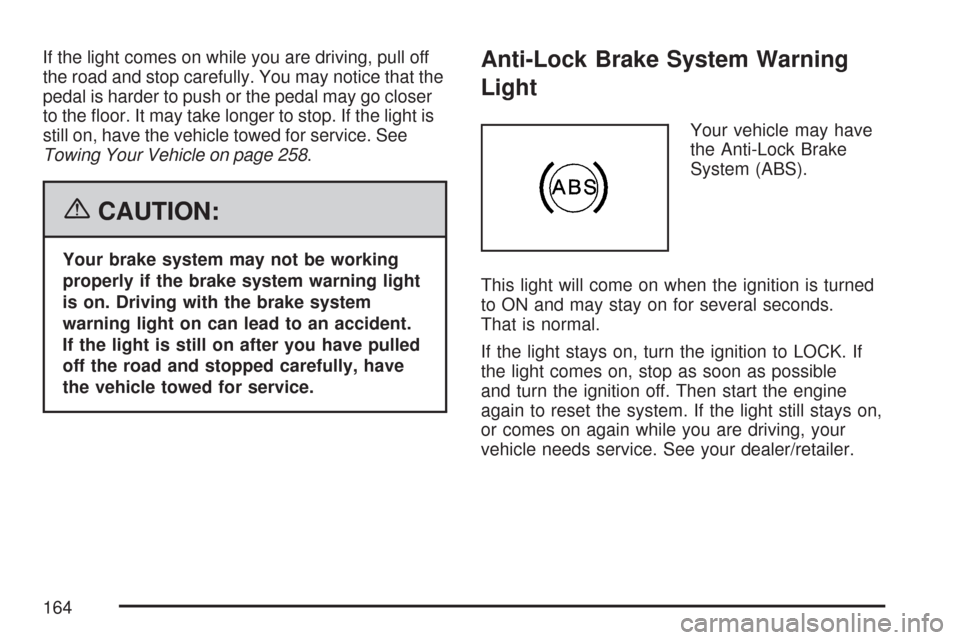
If the light comes on while you are driving, pull off
the road and stop carefully. You may notice that the
pedal is harder to push or the pedal may go closer
to the floor. It may take longer to stop. If the light is
still on, have the vehicle towed for service. See
Towing Your Vehicle on page 258.
{CAUTION:
Your brake system may not be working
properly if the brake system warning light
is on. Driving with the brake system
warning light on can lead to an accident.
If the light is still on after you have pulled
off the road and stopped carefully, have
the vehicle towed for service.
Anti-Lock Brake System Warning
Light
Your vehicle may have
the Anti-Lock Brake
System (ABS).
This light will come on when the ignition is turned
to ON and may stay on for several seconds.
That is normal.
If the light stays on, turn the ignition to LOCK. If
the light comes on, stop as soon as possible
and turn the ignition off. Then start the engine
again to reset the system. If the light still stays on,
or comes on again while you are driving, your
vehicle needs service. See your dealer/retailer.
164
Page 219 of 436
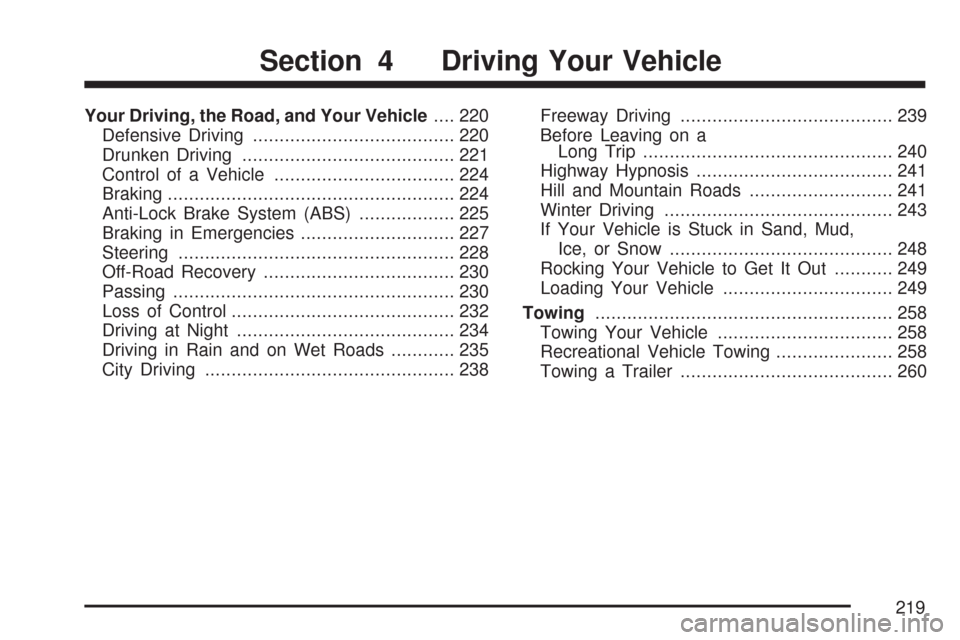
Your Driving, the Road, and Your Vehicle.... 220
Defensive Driving...................................... 220
Drunken Driving........................................ 221
Control of a Vehicle.................................. 224
Braking...................................................... 224
Anti-Lock Brake System (ABS).................. 225
Braking in Emergencies............................. 227
Steering.................................................... 228
Off-Road Recovery.................................... 230
Passing..................................................... 230
Loss of Control.......................................... 232
Driving at Night......................................... 234
Driving in Rain and on Wet Roads............ 235
City Driving............................................... 238Freeway Driving........................................ 239
Before Leaving on a
Long Trip............................................... 240
Highway Hypnosis..................................... 241
Hill and Mountain Roads........................... 241
Winter Driving........................................... 243
If Your Vehicle is Stuck in Sand, Mud,
Ice, or Snow.......................................... 248
Rocking Your Vehicle to Get It Out........... 249
Loading Your Vehicle................................ 249
Towing........................................................ 258
Towing Your Vehicle................................. 258
Recreational Vehicle Towing...................... 258
Towing a Trailer........................................ 260
Section 4 Driving Your Vehicle
219